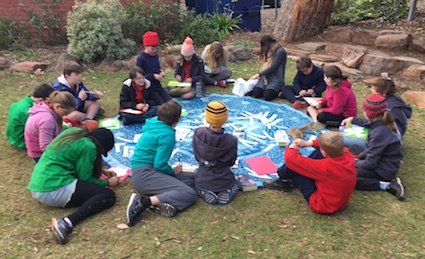
BIO stands for Both Inside and Out. It is an approach to topic work that the children at Upper Sturt Primary School use almost on a daily basis. In their words, it is “an integrated subject, which is employed as a whole school approach. Explicit texts are used for reading comprehension and modelled writing. Maths concepts are built in to the topic, and students have a chance to touch on multiple curriculum areas throughout the life of the topic. This format of learning is inspired by Talking Tubs and 3D Mind Maps. Talking tubs are used to encourage children to share their knowledge of a new topic and then ‘map’ or plan what they would like to learn.”
This introduction to the topic is an adaptation of an approach that Claire Warden and Mindstretchers have developed. It has been lovely to see this applied in a primary context. Upper Sturt Primary is unusual in that it is the an Australian state school which primarily works outside, using a nature-based approach.
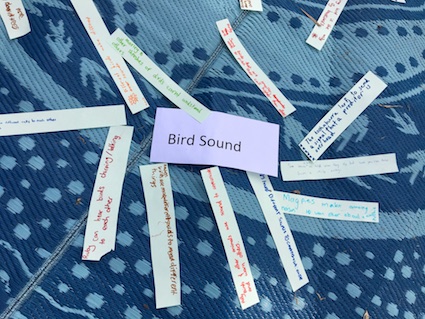
I had the privilege of witnessing the introduction to a bird topic with the oldest age group. Each child was given lots of strips of paper and a cloud. They wrote their names on all the pieces straightaway so that it was clear who was contributing to the different conversations. On the strips of paper, facts and statements were written. It was undertaken in a sequential way. The teacher produced a series of provocations. It began with a photo of a bird eggs in a nest and the children were invited to write and talk about what they knew about relating to this photo. Further photos and other resources were also revealed with other links to the subject of birds including: photo of a knocked down log, a rainbow map of the world, a box of sawdust, supplies of nesting material, bird sounds, migration patterns of birds and a bag of bird food.
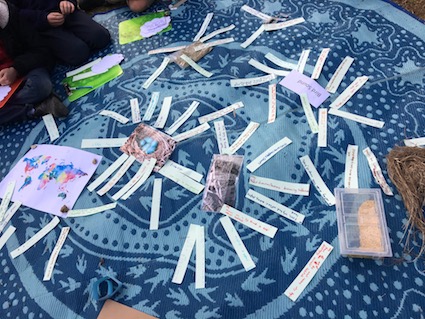
Within 20 minutes the area was rapidly filled with the children’s comments. Theresa, the teacher, took care to follow up with careful questioning such as “What do you know about birds and their habitat destruction?” and “What do you know about sawdust and what do you wonder about this in relation to birds?” It is only the second time she has used this approach, being a new member of staff so it is still a learning process for her.
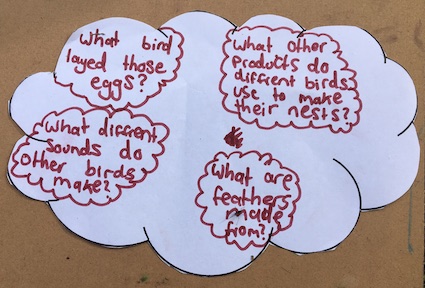
As well as strips of paper, the children also had clouds. These were used for writing “wonderings” as the 3D mind map was being created by the class of children. The older children then copied these into their journals. Over the course of the project, their job is to reflect and find out possible answers and other investigations about the birds.
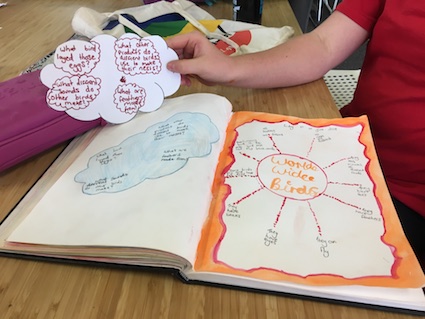
Each teacher then gathers all the strips and word clouds to consider the statements and to steer the direction of the topic in order to meet the interests and needs of the children as well as the curriculum expectations. The wonderings are grouped and mapped onto the curriculum. With some classes, the children have to consider whether these wonderings can be followed up through Google searches or are un-Googleable. This is a useful way of discriminating questions and research.

The BIO Learning is exactly what it says it is. Some children chose to do their journal work inside their classroom. Some were outside on picnic benches. Others were sitting elsewhere outside. The children were expected to make the decision about where best to undertake the work and trusted to get on and do it. The maths and literacy work is integrated into the projects. For example, when considering maths, there’s a lot of data handling in monitoring birds visiting a feeding station. Learning about wingspans of different birds enables practical measurement of length, including conversion between metres, millimetres and so on for older children. Migration routes and behaviours enable larger distances and the use of equations such as speed, distance and time to be used as well as developing and applying knowledge of bearings.
By adopting a whole school approach, all the children have the opportunity to learn from the other classes. Furthermore criteria are shared with the children in each class about what they are expected to achieve within the project. Each class has also a clear focus for the show day. A date is agreed and set for sharing what has been learned with the parents. The youngest class will focus on a chosen local bird to study and create bird sculptures. The middle class will be creating field guides to local birds which will help them learn about relevant information and characteristics of different birds. The oldest class will be studying birds globally so at the showcase a representation of birds from all over the world will be evident.
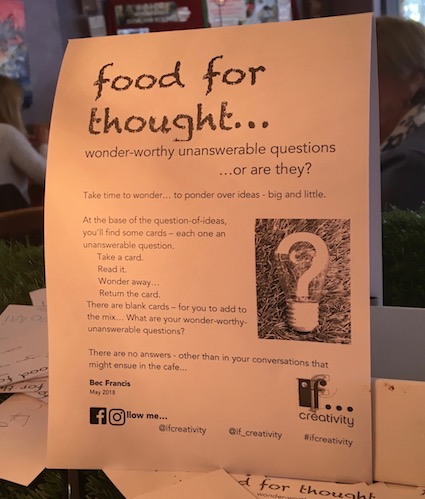
A couple of days later, I was having lunch in a nearby cafe. The above poster and cards caught my attentions. The cafe was inviting visitors to also consider wonderings… it must be catching on!
Finally, this is a lovely example of BIO Learning in practice – enjoy this video!
This blog post was originally published in June 2018. Since then, there has been a change in headship thus, this post is a snapshot in time rather than reflecting current practice.






























BIO learning… makes perfect sense. Connecting children with what they want and need to know per topic and being trusted to make the decision about where best to work. Thanks for sharing this, Juliet!
Hello Deborah
Thanks for this comment. I thought it is a lovely approach and makes good sense.
Our grandchildren are at Upper Sturt… started last year. We have been blown away with how they have thrived and blossomed in this learning environment. This was shown when immediately Christmas was over, they asked if they could go back to school! Exactly the love of learning that education should foster. Well done Upper Sturt!
Thanks for that feedback. Often the concept of a bush or outdoor school appears strange. However Upper Sturt effectively demonstrates that you can have a lovely positive challenging school experience and for this to happen outside.